

BrainHQ from Posit Science. The 5 Steps of Effective Technology Integration - Getting Smart by Dave Guymon - edchat, EdTech, education. In schools, districts, and departments of education alike, a trend toward integrating technology into the education process is on the rise.

One could argue that it always has been. But with the proliferation of Internet access in school buildings and the ubiquity of mobile computing devices, educators are taking note and beginning to consider new ways they can include these tools into their classroom instruction. The formalized field of educational technology is still in its infancy. As a result, professional development and training practices are still being refined. As they are teachers in many school districts are choosing to lead their own technology integration through experimental applications with their students and curriculum. 1. 2. 3. 4. 5.
That a shift toward technology in education is on the rise isn’t what excites many educators in the profession. Encouraging Teacher Technology Use. Technology use in classroom instruction can vary greatly from school to school.
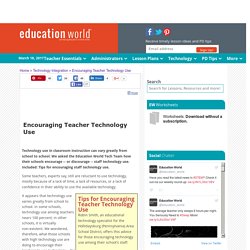
We asked the Education World Tech Team how their schools encourage -- or discourage -- staff technology use. Included: Tips for encouraging staff technology use. TIP model. Resources for Technology Integration. In this section, you will find materials and resources for teaching about how to successfully integrate technology into the classroom, whether you are conducting a two-hour session or class or can spend a day or two on the topic.

We believe you will find much here from which you can build a set of experiences tailored to class participants for the purpose of exploring technology integration: More Edutopia.org Resources on Technology Integration: Top Edutopia.org Case Study Videos on Technology Integration: Technology Implementation in Schools: Key Factors to Consider. New technologies have changed teaching and learning in a number of ways—from graphing calculators to online lesson plans to virtual field trips and simulated dissections, educational technologies can help students access content in new and often exciting ways.
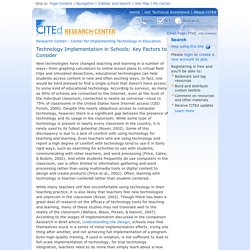
In fact, one would be hard pressed to find a single school that doesn’t have access to some kind of educational technology. According to surveys, as many as 95% of schools are connected to the Internet; even at the level of the individual classroom, connection is nearly as universal—close to 75% of classrooms in the United States have Internet access (CEO Forum, 2000). Despite this nearly ubiquitous access to computer technology, however, there is a significant gap between the presence of technology and its usage in the classroom. While some type of technology is present in nearly every classroom in the country, it is rarely used to its fullest potential (Royer, 2002). Professional Development Leadership. Welcome to the LAT Web Site! 123D Catch - How to Make 3D Models from Pictures. Middle School - PhET Simulations. TPACK.org. The community of teachers, researchers, and others interested in TPACK is diverse and growing.
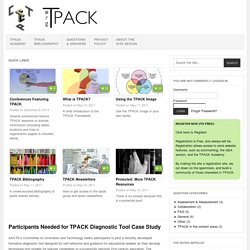
There are a number of ways to interact with others about TPACK. In this post, we highlight four of the ways – 1) Facebook, 2) Twitter, 3) Mendeley, and 4) sections of the TPACK.org site – in which TPACK.org is involved with social media. If there are other ways you or others are discussing TPACK, we would love to hear about and share them here.
Facebook A poll conducted on TPACK.org asked “Should there be a TPACK Facebook group or page?” Mendeley Mendeley is publication management software in which there is an active group. Twitter There is an active TPACK community on Twitter. TPACK.org In addition to the Facebook group, Twitter community, and the Mendeley group, the questions and answers section on TPACK.org is a good place to ask general questions about TPACK-related topics. Dr. Joshua M. Future Ready Learning. What is Future Ready Learning?
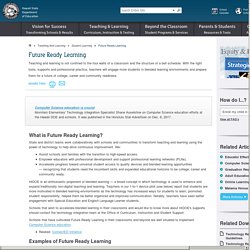
State and district teams work collaboratively with schools and communities to transform teaching and learning using the power of technology to help drive continuous improvement. We: Assist schools and families with the transition to high-speed access. Empower educators with professional development and support professional learning networks (PLNs). Accelerate progress toward universal student access to quality devices and blended learning opportunities — recognizing that students need the incumbent skills and expanded educational horizons to be college, career and community ready.
Internet safety. Rules of the road Users of the Hawaii State Department of Education (HIDOE) Internet Portal System, Internet services and digital devices must comply with: Acceptable Use Guidelines: For employees, contracted workers, volunteers and all other non-student and non-parent users of HIDOE-owned or leased digital devices.
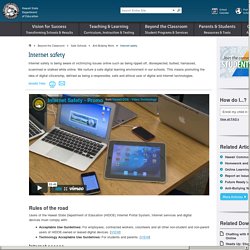
[VIEW]Technology Acceptable Use Guidelines: For students and parents. [VIEW] Internet access Access to the Internet at Department schools and facilities is controlled through what's known as the Captive Portal — a cluster of Cisco Ironport appliances that are positioned at the perimeter of our Internet Portal System. Future Ready Learning. TPACK.ORG. Lee Shulman. Lee S.
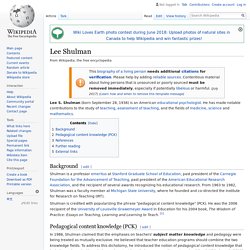
Shulman (born September 28, 1938) is an American educational psychologist. He has made notable contributions to the study of teaching, assessment of teaching, and the fields of medicine, science and mathematics. Background[edit] Shulman is a professor emeritus at Stanford Graduate School of Education, past president of the Carnegie Foundation for the Advancement of Teaching, past president of the American Educational Research Association, and the recipient of several awards recognizing his educational research. From 1963 to 1982, Shulman was a faculty member at Michigan State University, where he founded and co-directed the Institute for Research on Teaching (IRT). Shulman is credited with popularizing the phrase "pedagogical content knowledge" (PCK). Pedagogical content knowledge (PCK)[edit] In 1986, Shulman claimed that the emphases on teachers' subject matter knowledge and pedagogy were being treated as mutually exclusive.
References[edit] Further reading[edit] Ball, D. Professor Seymour Papert. K-6 Literacy. Access the interactive [K-6 Literacy] Activity Types taxonomy.
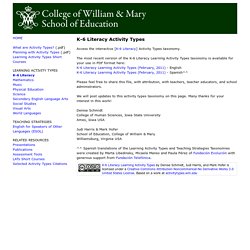
The most recent version of the K-6 Literacy Learning Activity Types taxonomy is available for your use in PDF format here: K-6 Literacy Learning Activity Types (February, 2011) - English K-6 Literacy Learning Activity Types (February, 2011) - Spanish^^ Please feel free to share this file, with attribution, with teachers, teacher educators, and school administrators. We will post updates to this activity types taxonomy on this page. Many thanks for your interest in this work! Denise Schmidt College of Human Sciences, Iowa State University Ames, Iowa USA.